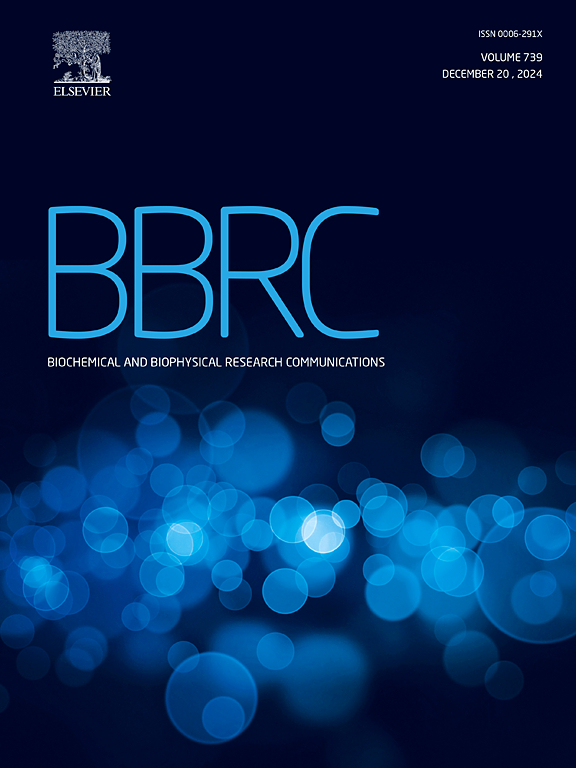白细胞介素-11 信号在代谢功能障碍相关性脂肪性肝炎小鼠模型中对肝纤维化的作用有限。
IF 2.5
3区 生物学
Q3 BIOCHEMISTRY & MOLECULAR BIOLOGY
Biochemical and biophysical research communications
Pub Date : 2024-11-01
DOI:10.1016/j.bbrc.2024.150938
引用次数: 0
摘要
肝纤维化是肝脏中胶原纤维的异常堆积,由多种慢性肝病引起,包括病毒性肝炎、酒精性脂肪性肝炎和代谢功能障碍相关性脂肪性肝炎。在慢性肝炎的各种症状中,肝纤维化是决定患者预后的最关键因素。广泛的肝纤维化会导致肝硬化和肝癌,缩短患者的寿命。然而,目前还没有药物被批准用于治疗肝纤维化。因此,迫切需要确定肝纤维化的分子机制和药物靶点。白细胞介素-11是白细胞介素-6家族炎症细胞因子的成员,参与炎症和组织修复的多个过程。最近的报道还表明,白细胞介素-11 在不同器官中具有促纤维化的功能。在这项研究中,我们使用胆碱缺乏、氨基酸定义的高脂饮食(一种代谢功能障碍相关性脂肪性肝炎的小鼠模型,会迅速发展为肝纤维化)来检测白细胞介素-11 在肝脏中的纤维化潜力。虽然在这种病理模型中,白细胞介素-11在肝脏中特异性上调,但白细胞介素-11信号的缺失在肝损伤、炎症、纤维化和信号转导通路中起着次要作用。我们的研究结果表明,白细胞介素-11的促纤维化功能可能因器官和病因而异。本文章由计算机程序翻译,如有差异,请以英文原文为准。
Interleukin-11 signaling plays limited roles for liver fibrosis in a mouse model of metabolic dysfunction-associated steatohepatitis
Liver fibrosis, an abnormal accumulation of collagen fibers in the liver, is caused due to several chronic liver diseases including viral hepatitis, alcoholic steatohepatitis, and metabolic dysfunction-associated steatohepatitis. Among the various symptoms of chronic hepatitis, liver fibrosis is the most crucial factor in determining patient prognosis. Extensive liver fibrosis leads to cirrhosis and liver cancer and shortens the lifespans of patients. However, no drug is currently approved for the treatment of liver fibrosis. Therefore, the identification of molecular mechanisms and druggable targets of liver fibrosis is urgently needed. Interleukin-11 is a member of the interleukin-6 family of inflammatory cytokines that is involved in multiple processes of inflammation and tissue repair. Recent reports also suggest the pro-fibrogenic function of interleukin-11 in various organs. In this study, we examined the fibrogenic potential of interleukin-11 in the liver using a choline-deficient, amino acid-defined high-fat diet, a mouse model of metabolic dysfunction-associated steatohepatitis that rapidly develops liver fibrosis. Although interleukin-11 was specifically upregulated in the liver in this pathological model, the loss of interleukin-11 signaling played minor roles in liver injury, inflammation, fibrosis, and signal transduction pathways. Our results indicate that the pro-fibrogenic function of interleukin-11 may vary among organs and disease etiologies.
求助全文
通过发布文献求助,成功后即可免费获取论文全文。
去求助
来源期刊
CiteScore
6.10
自引率
0.00%
发文量
1400
审稿时长
14 days
期刊介绍:
Biochemical and Biophysical Research Communications is the premier international journal devoted to the very rapid dissemination of timely and significant experimental results in diverse fields of biological research. The development of the "Breakthroughs and Views" section brings the minireview format to the journal, and issues often contain collections of special interest manuscripts. BBRC is published weekly (52 issues/year).Research Areas now include: Biochemistry; biophysics; cell biology; developmental biology; immunology
; molecular biology; neurobiology; plant biology and proteomics

 求助内容:
求助内容: 应助结果提醒方式:
应助结果提醒方式:


